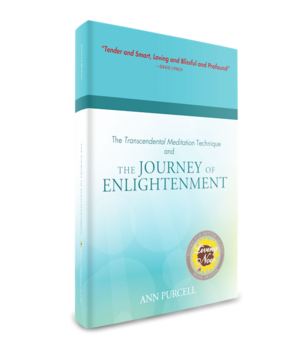Most people think of the Transcendental Meditation (TM) technique as an effective way to reduce stress. Hundreds of scientific research studies show that TM can help improve all aspects of physical, mental, and emotional well-being and verify that it is the most effective technique available to reduce anxiety.
However, very few people are aware of the ultimate benefit of TM, which extends far beyond mere stress reduction. TM is a direct means to fully unfold one's innate potential -- enlightenment.
Misconceptions about TM
Maharishi Mahesh Yogi, who brought TM to the West, recalled that in 1959 the first article on TM came out in San Francisco, headlined "Non-medicinal Tranquilizer," and described TM as a means to cure insomnia.
The local TM practitioners were excited to share this news with Maharishi. As one individual read the article to him, Maharishi fell silent. When asked what he thought about the article, Maharishi replied, "Cruel." Maharishi explained that in India people learn meditation to achieve enlightenment -- to become fully awake -- yet here in the West it was being hailed as a means to fall asleep!
Tim Ferris, author of the 4-Hour Workweek, interviewed Tara Brach, a psychologist who is a well-known author and lecturer on Buddhism. Tim mentioned that he practices TM and asked Dr. Tara Brach what she thought about it.
Tara replied:
"TM is primarily a concentrated practice: You are taking a mantra, or a set of sacred words, and repeating them and repeating them and the benefit of concentration, which is the narrowing of the lens of focus, is that it actually collects the attention and the mind gets quiet. And when the mind is quiet, there can be experiences of bliss and serenity and peace and so on. That's what TM does, it gives you a break from that incessant inner dialogue and the more you practice it, the more easily it is to collect the mind...
"For me the limitation is -- it doesn't allow you see into the nature of reality; and by that I mean -- it doesn't bring a kind of presence that allows you to sense what is actually happening now. Most of our understanding of reality is conceptual -- we have ideas about things, and to really have a clear penetrating insight, we need to be present. TM aims the mind at something, but it doesn't open the attention so that whatever arises, you start learning how to be with it. To me, the power and freedom of mindfulness is you start getting the knack of being with whatever arises."
There are several points in her response that I would like to address. The technique of TM does not involve concentration. The state of transcendental consciousness produced by TM is an experience of bliss consciousness; the mind will naturally settle down to this level without any concentration or effort because the mind automatically goes to that which is more pleasing.
Dr. Brach is correct in saying that one uses a mantra, which leads to "experiences of bliss and serenity." One important, yet subtle point of clarification: During TM the mantra does not narrow the mind's focus, but rather allows the experience finer, more expanded states until one experiences transcendence -- unbounded awareness. This is different from just collecting and quieting the mind.
Reality Is As You Are
The next misconception is that TM is limited since it "doesn't allow you to see into the nature of reality" and be present to the moment. Everyone's reality is different and depends on one's level of consciousness. The deepest, most universal level of reality is present within everyone at the most silent level of one's being. Through the daily practice of TM, expanded awareness along with the ability to focus sharply are developed naturally. Thus being present in the moment is an automatic feature of TM.
Transcendental consciousness is stabilized through regular alternation of meditation and activity until the nervous system can maintain both at the same time -- awareness of the non-changing, universal level along with full focus in activity -- cosmic consciousness. In this state one is naturally present without any intellectualizing or trying to be present.
Unity Consciousness -- Going the Whole Way
Dr. Brach concludes that TM does not take you "the whole way," e.g., to the state of being mindful.
Maharishi says that the "whole way" is to live unity consciousness, in which we see the infinite, transcendental value of our Self shining through the boundaries of every perception. We still perceive the differences, but unity predominates. In his commentary on the Bhagavad-Gita, Maharishi explains:
"The height of realization ... is to realize the supreme oneness of life in terms of one's own Self. No diversity of life is able to detract from this state of supreme Unity. One who has reached It is the supporter of all and everything, for he is life eternal. He bridges the gulf between the relative and the Absolute ... Yoga [Union] in this state has reached its perfection; there is no level of Union higher than this that he has gained. He stands established on the ultimate level of consciousness."
I would love to have a conversation with Tim Ferris and Tara Brach to clarify additional misunderstandings expressed in their interview. Here, I am simply explaining why Transcendental Meditation is far, far more than a mere stress buster, and much more than just a way to take a "break from that incessant inner dialogue..."
Reduction of stress is an important step in normalizing the physiology so that it can function in an integrated and healthy manner, but "busting" stress is, after all, a side benefit of TM. Let's enjoy the natural outcome of this technique -- growing in unity consciousness -- enlightenment.
 Ann Purcell is an author and has been teaching meditation around the world since 1973. In addition, she has worked on curricula and course development for universities and continuing education programs. Her latest book, The Transcendental Meditation Technique and the Journey of Enlightenment was released on March 13, 2015
Ann Purcell is an author and has been teaching meditation around the world since 1973. In addition, she has worked on curricula and course development for universities and continuing education programs. Her latest book, The Transcendental Meditation Technique and the Journey of Enlightenment was released on March 13, 2015

